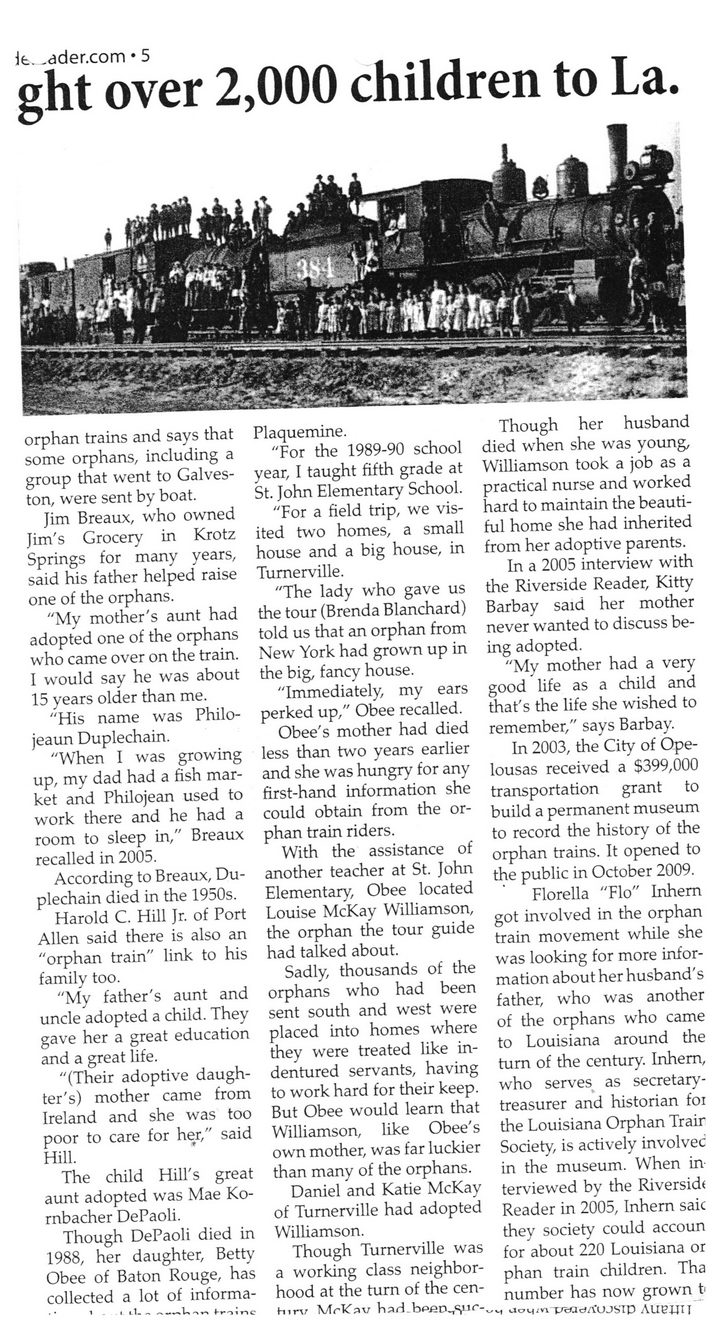This text was obtained via automated optical character recognition.
It has not been edited and may therefore contain several errors.
k. -ader.com • 5 ght over 2,000 children to La. orphan trains and says that some orphans, including a group that went to Galveston, were sent by boat. Jim Breaux, who owned Jim's Grocery in Krotz Springs for many years, said his father helped raise one of the orphans. "My mother's aunt had adopted one of the orphans who came over on the train. I would say he was about 15 years older than me. "His name was Philo-jeaun Duplechain. "When I was growing up, my dad had a fish market and Philojean used to work there and he had a room to sleep in," Breaux recalled in 2005. According to Breaux, Duplechain died in the 1950s. Harold C. Hill Jr. of Port Allen said there is also an "orphan train" link to his family too. "My father's aunt and uncle adopted a child. They gave her a great education and a great life. "(Their adoptive daughter's) mother came from Ireland and she was too poor to care for her," said Hill. The child Hill's great aunt adopted was Mae Ko-rnbacher DePaoli. Though DePaoli died in 1988, her daughter, Betty Obee of Baton Rouge, has collected a lot of informa- ------—,U- Plaquemine. "For the 1989-90 school year, I taught fifth grade at St. John Elementary School. "For a field trip, we visited two homes, a small house and a big house, in Tumerville. "The lady who gave us the tour (Brenda Blanchard) told us that an orphan from New York had grown up in the big, fancy house. "Immediately, my ears perked up," Obee recalled. Obee's mother had died less than two years earlier and she was hungry for any first-hand information she could obtain from the orphan train riders. With the assistance of another teacher at St. John Elementary, Obee located Louise McKay Williamson, the orphan the tour guide had talked about. Sadly, thousands of the orphans who had been sent south and west were placed into homes where they were treated like indentured servants, having to work hard for their keep. But Obee would learn that Williamson, like Obee's own mother, was far luckier than many of the orphans. Daniel and Katie McKay of Tumerville had adopted Williamson. Though Tumerville was a working class neighborhood at the turn of the cen- Hiro VfrVav Though her husband died when she was young, Williamson took a job as a practical nurse and worked hard to maintain the beautiful home she had inherited from her adoptive parents. In a 2005 interview with the Riverside Reader, Kitty Barbay said her mother never wanted to discuss being adopted. "My mother had a very good life as a child and that's the life she wished to remember," says Barbay. In 2003, the City of Opelousas received a $399,000 transportation grant to build a permanent museum to record the history of the orphan trains. It opened to the public in October 2009. Florella "Flo" Inhem got involved in the orphan train movement while she was looking for more information about her husband's father, who was another of the orphans who came to Louisiana around the turn of the century. Inhem, who serves as secretary-treasurer and historian foi the Louisiana Orphan Trair Society, is actively involved in the museum. When in terviewed by the Riversid* Reader in 2005, Inhem saic they society could accoun for about 220 Louisiana or phan train children. Tha number has now grown t i JoiimpaidA'UJSi'ip AUBJJU

Orphan Train Riders of BSL Document (154)